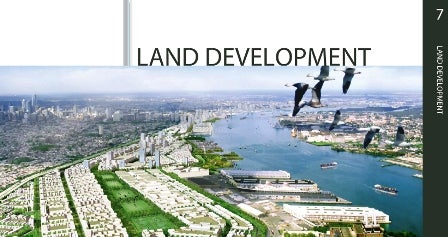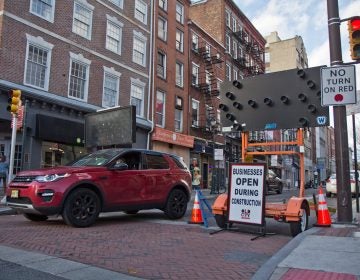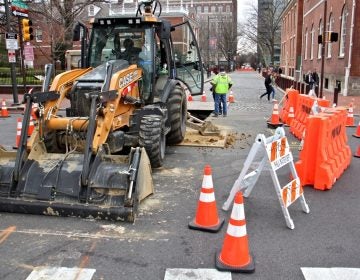Waterfront Overlay plans head to Council

May 19
By Thomas J. Walsh
For PlanPhilly
The Philadelphia City Planning Commission on Tuesday approved two controversial zoning bills for the Central Delaware Riverfront – an overlay meant to be an interim set of guidelines for the Penn Praxis Vision and Action plans, and a remapping for the “Old City/Northern Liberties/Fishtown” section of the Delaware, both introduced by City Councilman Frank DiCicco in March.
The first bill is intended as a “stop-gap measure” to support the Penn Praxis goals until a fully detailed plan is created and delivered in final form, estimated to be in about a year to 16 months. The bill, which is expected to pass through City Council before its June recess, “has been through many amendments,” said Planner Martin Gregorski, “some as late as today.” It would encompass the area bounded by Allegheny Avenue to the north, east to the river, Oregon Avenue to the south and Interstate 95 to the west.
The interim overlay would establish a 100-foot setback for future development (or 10 percent of the total lot area, whichever is less), to allow for park space, jogging and biking trails and ecological concerns – though it allows for “exigent circumstances.” It also mandates public waterfront access points, to be provided at a width of 12 feet on piers and 25 feet at all other locations. Properties would be exempted by the Planning Commission where that is not possible.
The second bill changes the zoning designations in the area from Berks Street in Fishtown, south to Market Street in Old City, and also hemmed by the river and I-95.
The bills were read and considered together. As was the case with past presentations of the overlay legislation, more than a dozen supporters testified in favor of the overlay and overall riverfront plan, including Penn Praxis Executive Director Harris Steinberg, Marilyn Taylor, (the dean of Penn’s School of Design but testifying as a member of the Delaware River Waterfront Corp.) and members of various river ward civic organizations.
Likewise, real estate attorney Michael Sklaroff and the developer and former city planning chief Craig Schelter were again protesting the bills. Sklaroff said it was “remarkable” that the recommendation by the Planning Commission staff for the overlay was “in concept.”
“This is not a design. This is not a plan,” Sklaroff said. “This is an ordinance which is going to be presented at the [City Council] Rules Committee.” By City Charter, “I believe you folks either need to approve or disapprove of it. You’re talking about ‘conceptual.’ I think what that means is it’s not far enough along.”
“It is almost inconceivable to me that under our City Charter and due process to have this kind of subjective decisions on zoning, where the Planning Commission has complete discretion,” Sklaroff argued, saying that the city Law Department needs to take a long, hard look at precedent for the overlay. “This ordinance threatens the tax base.”
Sklaroff said the city’s Board of Revision of Taxes considers the waterfront parcels affected to very valuable. “Many of them have very high assessments based upon acquisitions and sales in 2002.” What will happen if the overlay, “in all its uncertainty” is passed, is that waterfront landowners will apply for lower assessments to the BRT, he said. The result will be possibly millions in lost city revenues for an indeterminate period, and that impacts could be felt on city services such as swimming pools, police and schools.
“There’s no such thing as zoning as a stop-gap measure,” Sklaroff said.
Matt Ruben, president of the Northern Liberties Neighbors Association, said the overlay is not a “concept,” but the overdue realization of years of planning efforts by his organization and others that have sought to stop random development.
“If you do not act on this overlay, what will happen is, no matter how bad the economy is, you don’t need financing to pull a permit,” Ruben said, referring to developers in general. “We don’t want landowners, who have been land-banking for years in many cases with commercial properties, to pull the most vague permits as they can to lock in the legal right to build right up to the riverfront, because there’s not anyplace that says they can’t.
“That is what is at stake right now,” Ruben said. “Will there be anything left to apply the overlay to, if you don’t act on this today?”
“An enormous amount of commitment and investment went into [this], with the authorization and promotion, really, of the city for this Vision Plan for the waterfront, said Planning Commission Executive Director Alan Greenberger. “This Commission accepted it as a set of working guidelines at last month’s meeting.”
The overlay sets guidelines for prohibitive uses, desirable uses, about the relationship of any new development to the street and other factors well beyond the setback, Greenberger said. “Are any of these things going to happen in the next 12- to 16-month period? Well, that’s anybody’s guess.”
The economy and credit markets will dictate which direction the planning will go, but in the meantime, “We believe we do need the interim legislation,” Greenberger said, to mitigate the kind of negative development “that has plagued the waterfront to this date.”
More riverfront
Three other major pieces of zoning legislation, somewhat diminished by the waterfront overlay hoopla, were also approved by the Commission on Tuesday.
In fact, nothing less than the creation of a new “Delaware River Conservation District,” introduced by City Councilwoman Joan Krajewski in late April, passed muster. Its setback is half that of the Central Delaware overlay, at 50 feet, owing to the area’s tighter geography and the presence of industrial lands that are either in use or could be again. It encompasses the area from the Bucks County Line to the north down to Allegheny Avenue.
This conservation district is tied directly to hopes for the “East Coast Greenway” to pass south, unimpeded, through Philadelphia, first from the Delaware shores, then through some sort of Center City or South Philadelphia connection, and eventually to the Schuylkill River Trail – already in full development mode – and into the Cobbs Creek area. (Fundraising for the East Coast Greenway is currently underway by the Delaware River City Corp.)
The ordinance requires owners and developers to set aside land for a buffer with new construction, improvements or major alterations, and restricts plans to the “Design Criteria of the North Delaware Trail.” PIDC (Philadelphia Industrial Development Corp.) is to hold the land until such a buffer is assembled, then transferred to Fairmount Park.
Greenberger said the idea was approval of the idea in concept and to authorize his staff to continue to work on details.
Commissioner Patrick Eiding, who is president of the Philadelphia Council AFL-CIO, wore at least two hats during the entirety of the Planning Commission hearing. In this instance, he told Greenberger to be careful of “approving in concept,” because there could be developers that get the wrong message. “It does concern me because no matter how green you make something, people still need to make a living.”
Greenberger responded by saying there was no intention of superseding active businesses, which is why the concept and legislation is meant to be long-term.
Paul Lonie, capital program director for the Delaware River City Corp., said his organization is trying to negotiate long-term deals – but with only two private property owners.
Sklaroff questioned what the right-of-way impact would be, but said he was only seeking clarification, and not taking a position.
Patrick Starr, vice president of the Pennsylvania Environmental Council, said there has been deference to sites where there are, or could be, industrial jobs. “At this time this ordinance for a setback is an important piece of this multi-year work so far,” Starr said. “What we’ve done is thread the trail as best we can … We have made every effort to be as accommodating as possible.” A few years ago, Starr said, the coalition was pushing for this kind of zoning but “failed to be clear, and that is what got us into trouble.”
“If you are down to two properties, then hey, maybe good job,” Eiding said. “I’m just trying to look at the overall. I know the work has been done. But I really do concern myself with, ‘This begets that.’ Some people may look at our overlay as a deterrent to coming to the city. I’m a little afraid that maybe we’re going a little faster.”
Commissioner Natalia Olson de Savyckyj said Eiding was right to keep the big picture in mind, but added, “How long do we have to keep planning, and planning, and not getting to implementation?”
Likewise, Maya van Rossum, of the Delaware Riverkeeper Network, said, “You do send a message” with the overlay implementation to potential businesses coming to Philadelphia. “You’re telling them what kind of community you want to have in the future and what kind of business” you want. There will be some developers that will say they want no part of it, she said, but others that will “be really excited.” With the overlay, van Rossum said, “You actually move the ball forward.”
Eiding voted for approval, but kept up his cautionary role throughout. “So far in this city we haven’t seen the magic formula to bring jobs here,” he said.
K&T Railroad
Another Krajewski bill, authorizing the acquisition of the former Kensington and Tacony Railroad, was approved.
Planning staffer Larissa Klevan said the land is within the right-of-way of the rail line near the Old Frankford Creek bridge and Princeton Avenue, and includes the spur between Knorr Street and Princeton, terminating at Milnor Street. Another parcel is bounded by Unruh Street, the Pennsylvania State Fish and Boat Commission Property, and the river.
This land will also contribute to the development of a Delaware River Greenway, part of the East Coast Greenway.
Southport
A zoning bill for the eastern portion of the Navy Yard on the South Delaware riverfront was also approved. It comes on the heels of an “information only” presentation in March in which a 150-acre expansion of the Port of Philadelphia, south of the Packer Marine Terminal, was outlined by officials from Governor Ed Rendell’s office. The plans are thought to be contingent on the dredging of the Delaware River.
The bill (introduced by Councilwoman Marian Tasco for Council President Anna Verna on May 7), would re-map the “Southport” area to “LR,” or “least restricted” status, a significant change allowing more flexibility for multi-modal movement and other factors, according to staffer Paula Brumbelow.
The area is defined as between Broad Street, the Delaware Expressway, Pattison Avenue, Packer Avenue, the Delaware River and League Island Boulevard.
Other actions
The Commission also:
• Approved the construction of athletic fields, tennis courts, restrooms, a “seasonal air structure, or bubble structure,” and other buildings, with parking for 339 cars, on the campus of the University of Pennsylvania leading up to the edge of the Schuylkill Expressway and river. The areas are currently idle or used for surface parking.
• Disapproved the construction of 60 single-family, attached homes within a heavily industrial area of Northeast Philadelphia, at Aramingo Avenue, Church Street and Sepviva Street.
• Approved the remapping of the the former Wanamaker School at 11th Street and Cecil B. Moore Avenue for mixed-use redevelopment.
• Approved, with recommended provisions regarding signage and awnings, a zoning overlay that would enlarge the Tacony/Mayfair Special District.
• Approved a re-authorization of the Queen Village Neighborhood Conservation District, extending its status through June 2011.
CED ‘clarification’
The Commission approved a zoning bill that “exempts properties zoned ‘CED’ (“commercial entertainment district”) from the requirements of the North Delaware Avenue Special District Controls.”
The action “clears any potential conflict between the provisions of the CED regarding permitted uses and the prohibitions contained within this overlay district. This provision would exempt the Sugarhouse Casino from these use prohibitions, such as restaurants, nightclubs, and entertainment of guests as a main use.”
It also clears up “ambiguous language that resulted from the lack of definite sites at the time the CED district was written.” For instance, the phrase, “For specifically designated areas…” has been removed.
Significantly, the bill changes CED-designated parking requirements and exempts interim gaming facilities (Sugarhouse) with 1,700 or less slot machines from the requirement that no more than 10 percent of required parking be in open-air surface parking lots. Olson de Savyckyj cast the lone dissenting vote of the commissioners.
Notes
One item, regarding the re-zoning of 2116-32 Chestnut Street for developer The John Buck Co., was pulled from Tuesday’s agenda. Greenberger said more time was needed for community outreach, and to “hopefully solve some of the issues out there. In all likelihood, it will be on the agenda for June 9.” The developer proposes a 32-story mixed-use building, with 322 residential units an d office, community and fitness spaces. Also planned is about 9,200 square feet of retail space and 44,000 square feet of office space. Blueprints include 119 above-grade parking spots.
The next Planning Commission meeting will be a week earlier than usual, on Tuesday, June 9, to be held at the Academy of Natural Sciences. Greenberger said there will be a “rather large agenda,” with topics that are expected to draw large crowds. Read: Important casino discussions.
Greenberger said that the Delaware River Master Plan was posted on the Web site of the Delaware River Waterfront Corp. on Monday. A public meeting of the DRWC is scheduled for June 4 at 10 a.m.
He also noted that 27 applications were submitted for the job of project manager for the Delaware River Master Plan – five firms and 22 individuals. Interviewing could begin as early as next week.
Contact the reporter at thomaswalsh1@gmail.com.
WHYY is your source for fact-based, in-depth journalism and information. As a nonprofit organization, we rely on financial support from readers like you. Please give today.





